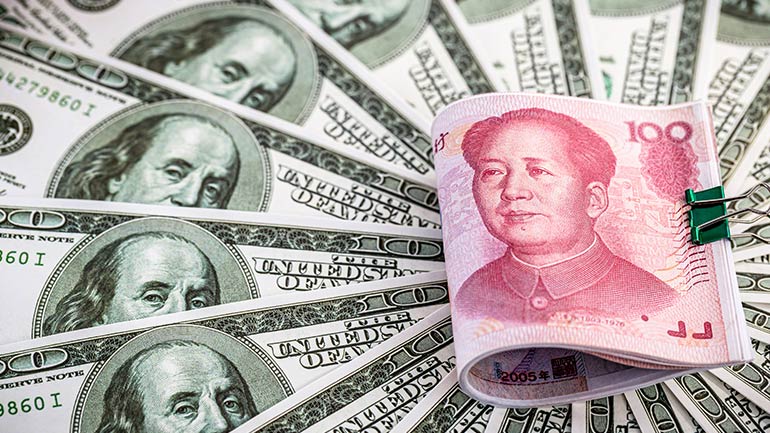A "Mighty Yuan" Belief Clashes with Devaluation Rumours
By: Alex Loo, Daniel Ghali, Gennadiy Goldberg
May 17, 2024 - 7 minutes 30 seconds
Rumours of a sudden CNY devaluation are rife, which are clearly at odds with the People's Bank of China (PBoC) "stable yuan" mantra over the past year. We don't foresee a sudden CNY devaluation though, due to several factors, which we discuss in this note.
Devaluation Rumours Trigger Unpleasant 2015 Memories
PBoC's relentlessly stronger USDCNY fixings have supported the CNY versus its peers, raising doubts over China's export competitiveness. USDCNY has traded in a tight range and is now just a whisker away from the top end of the 2% band. The fixings pattern is also eerily similar to 2015, just before China's devaluation, and investors are on the lookout, with some flagging a currency war in Asia given the weakness in the JPY, KRW and TWD amid an unstoppable USD. We expect more USD strength ahead and this begs the question if the PBoC will capitulate on its efforts to defend the yuan as a weaker CNY could be preferred to support economic growth.
While we can understand the logic of a weaker CNY to support the economy, we doubt the PBoC wants to trigger a disorderly move which will go against its "stable yuan" mantra in the past year even when USDCNY traded to a high of C¥7.34.
USDCNY Fixings vs Spot Price Action Brings Back Eerie Memories of 2015 Devaluation
Is the Commodity Market Telling Us Something?
Some investors have flagged the rise in copper inventories and PBoC's gold purchases as signposts of a looming devaluation attempt. It is a tail risk to be mindful of, but we wouldn't overplay these two data points.
- Copper: We see the rise in copper inventories as reflective of weak demand from industrial users in China. With China's housing policy pivoting toward a "destocking" direction, property construction in China is unlikely to pick up steam, explaining this acceleration in inventories.
- Gold: We were early to highlight this bizarre buying activity in gold markets: Uncovering Gold's Mystery Buyer. With CNY under pressure, authorities likely resorted to buying non-USD denominated assets and selling U.S. Treasuries to suppress the rise in the USD, explaining the aggressive nature of the gold purchases.
PBoC Has Been Gradually Stockpiling Gold
Why a Devaluation is Unlikely
Xi's "Mighty Yuan" Belief and Internationalisation Efforts
At the start of 2024, President Xi circulated his ideas on shaping China into a financial power. In particular, Xi saw the need for a 'mighty' currency, a strong central bank and strong financial institutions to attain this goal. These remarks underpin Xi's desire to increase the internationalization of the yuan.
Tracking the progress of CNY internationalisation, two points stand out:
- The CNY is the fourth most active currency in the world for global payments with a share of 4.7% in March 2024, surpassing even the JPY. Given that CNY accounted for <0.1% of global settlement when SWIFT started to track CNY in 2010, this is a big leap forward.
- Cross-border receipts and payments settled in yuan in 2023 hit C¥52.3, approximately 4 times the 2025 levels of 2015 levels. Any sudden devaluation would greatly hamper China's efforts to promote yuan usage, raising the hurdle to persuade foreign companies to transact in yuan in the future.
RMB's share of global currency payments surpassed JPY in March
The Intervention Bill Is Not Too High
Before the August 2015 devaluation, the PBoC spent U$300B over the prior four quarters from its official FX reserves to defend the yuan, drawing down from a high of U$4T in reserves in Q2 2024. One might argue that sustained intervention is too costly for China, and with the PBoC nowhere near hiking rates soon, another devaluation to realign the CNY makes sense.
Since 2017, PBoC's official FX reserves has remained flat which is odd given China's current account surplus. A plausible explanation is that state banks probably stopped transferring their FX purchases to the PBoC and have become PBoC's actors for FX interventions. Using FX settlements data from SAFE, we can back out the intervention bill and estimate an "unofficial" FX reserves measure.
By our estimates, state banks have been selling the USD to defend the yuan since Q4 2022, clocking U$20B in March 2024 and totalling U$64B over the past two quarters. In contrast to the U$300B that the PBoC spent over 2014/2015, the current intervention effort of U$64B since October 2023 is smaller and more manageable. We believe the PBoC has the tools and funds needed and won't hesitate to smooth out any excessive weakness in the CNY, sticking to its "stable yuan" mantra.
Financial Stability Is Paramount
Havoc in financial markets is likely the outcome after a sudden devaluation. We can expect heavy portfolio outflows as confidence in China's capital markets is undermined. Authorities' earlier efforts to stabilise capital markets have just begun to bear fruit, with China registering strong portfolio inflows YTD.
Equities & bonds inflows totalled U$42.5B in March on a three-month rolling sum basis, a level not seen since late 2021. The CSI300 is now also up 15% from the trough in late-January which has attracted back foreign investors' interest and inflows. Investors are feeling more positive on the capital markets outlook, reflecting the top brass efforts and the easy monetary policy outlook, which bodes well for bonds.
We doubt the Politburo will rubber stamp a devaluation and undo all the good work thus far. The last thing China's leaders want is Wall Street echoing the "China is uninvestable" tag again.
Exports Engine Not Collapsing
A strong yuan isn't doing any favours for exports, but export growth hasn't slumped to a degree that warrants a devaluation. Looking at quarterly trends, exports are gradually recovering after the sharp plunge in 2023 while the pace of global trade growth is set to double this year, which could put a floor under China's exports.
In 2015, the PBoC cited a high effective exchange rate as a reason behind the devaluation. China's real effective exchange rate (REER) - a measure that’s adjusted for inflation and trade with other nations - climbed 14% in a year, which presumably was too much for authorities to bear, especially given the poor growth outlook at that time. However, the REER has now retreated to 91.7 in March 2024 from a high of 106.5 in March 2022, and implies an improvement in China's trade competitiveness suggesting little need for a devaluation to boost exports.
China REER Is Notwhere Near 2015 Levels
FX Market Views: CNY Valuation-Price Disconnect Implies No Need for Intervention
Going into the U.S. election, the CNY's valuation may prove to be an issue. Looking at our Low-Frequency Fair Value (LFFV) framework, CNY sits 11% too cheap relative to our LFFV estimate against the USD, in stark contrast to the mere 2-5% gap in 2015 when devaluation occurred. Nations' FX policies may start to feature in the run-up to the Presidential elections, and we think China does not want to draw attention to the CNY. There are few economic benefits of a weaker FX, especially when domestic factors (e.g., housing/consumers) are the culprits of the slowdown.
However, what if the PBoC does go ahead with a devaluation? Which currencies will be the worst-hit? We've looked at the sensitivities (i.e., betas) of Asia and some G10 FX against the CFETS (trade-weighted yuan) in recent months and found that AUD, KRW and NZD are the most sensitive to moves in the CFETS and a sudden devaluation would likely trigger significant weakness in these currencies. Traditionally, the Antipodeans and South Korea have significant economic linkages to China, so these findings don't come as a surprise.
In summary, we do see scope for USDCNY to head towards C¥7.40 by year-end, reflecting a mixture of further USD strength and CNY weakness. We haven't changed our view that CNY is likely to underperform against global FX. Our main discomfort with the CNY devaluation rumour is that China won't tolerate any sudden moves in the currency and risk triggering a confidence crisis and capital flight. China may eventually concede on its CNY fixings and loosen its grip on CNY, but we suspect the PBoC will smooth out CNY weakness and not risk speculators piling into shorts and trigger heavy losses in the currency.
CNY Trading Too Cheap Relative to Fundamentals
Rates Market Views: Devaluation Would See Treasuries Cheapen Sharply
Treasury market investors live in perpetual fear of China's FX intervention since this involves China selling Treasuries en masse to fuel CNY purchases. While Chinese holdings have declined to about 4% of the marketable Treasury debt from a peak of 15% in 2011, we estimate that China still owns approximately U$1.1T in Treasuries. China shed nearly U$500B in holdings from 2014 and 2016 as part of its intervention efforts — a move which coincided with an enormous drawdown in China's FX reserves.
While part of the decline in Chinese Treasury holdings may have been accomplished by China stopping purchases and allowing some of its holdings to mature, China sold Treasuries outright in late-2015. This selling significantly unsettled the Treasury market at the time, cheapening Treasuries sharply relative to Overnight Indexed Swap (OIS).
After a period of cheapening over the past year, Treasuries have begun to richen vs OIS in recent months as bank portfolios have started buying fixed income again. However, any indication of selling by China would likely cheapen Treasuries sharply, tightening two-to-seven-year swap spreads. Outright yields may continue to move with macro drivers, but we expect Treasury valuations to shift materially on any FX intervention.
Chinese Treasury Holdings Have Declined Sharply Since 2023, Keeping Investors Nervous
Subscribing clients can read the full report, A "Mighty Yuan" Belief Clashes With Devaluation Rumours, via the TD One Portal












